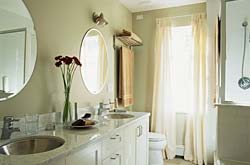Choosing Green: Bathroom Remodels
See if We Have Top-Rated
Green Professionals in Your Area

Bathroom remodels continue to be one of the most popular, and smart, investments for homeowners across the country. But what about going green in the bathroom? It's a no-brainer that a green bathroom remodel will save you on energy costs and drastically reduce your home's water usage. What many homeowners don't realize, however, is that green bathrooms are cutting edge when it comes to designing more attractive, healthier, and more comfortable remodels.
The Cost of Going Green
Placing a price tag on the cost of going green with your bathroom remodel is easier said than done. After all, the level of green each homeowner is willing to commit to is different, as are the individual specifications of each project. That said, green bathroom remodeling is not necessarily a higher cost remodel. What green bathroom remodeling does is to guarantee large energy savings over the life of your remodel.
Going green isn't just about reducing your monthly utility costs. It's about creating healthier living environments for you and your family, utilizing long lasting and low-maintenance materials so you'll lose less time to maintenance chores and repairs, and emphasizing environmental responsibility so you can rest easy knowing that you're doing everything you can to pass a better world onto your children and grandchildren. As you can see, assigning value in the world of green remodeling goes beyond assessing a final cost in dollars and cents.
Tips for Your Green Bathroom Remodel
Whether you're gutting your bathroom and starting from scratch or just replacing a few fixtures, here are some specific steps you can take to introduce green into your bathroom remodeling project.
- Install low flow faucets and showerheads. They can reduce water usage at these fixtures by up to 60 percent.
- Install low-flush, high-efficiency toilets. Older toilets use between 3.5 and 7 gallons per flush. New models do the job just as well with 1.6 gallons of water or less.
- Install radiant heating. It's more efficient and healthier than forced air.
- Insulate plumbing, and remove it from outside walls. Doing so reduces heat loss as water travels from your hot water heater to the faucet, and saves on water heating costs.
- Consider replacing your old hot water heater with a newer, more efficient model. High-efficiency fossil fuel water heaters, tankless water heaters, and heat pump water heaters are all sound energy savings solutions. Or upgrade your present heater with an insulation jacket, heat traps, and a water heater timer.
Green Bathroom Remodeling Tips for a Healthier Home
Urea formaldehyde, vinyl chloride gasses, volatile organic compounds, and toxic mold might sound like the beginning of a toxicology report, but all are actually chemicals and byproducts commonly associated with building materials used in the bathroom. Their presence has been linked to everything from rising levels of childhood asthma to much more serious maladies like cancer, repressed immune systems, and nervous system damage. Here is a list of things to look for, and to look out for, in pursuit of the healthiest bathroom possible.
Make your bathroom all it can be! Use this link for a professional
Bathroom Remodel
- Investigate your local water supply and install filters on sink faucets and showerheads. Your water will be healthier, taste better, and be safer for bathing, especially for those with chemical sensitivities.
- Design with ventilation in mind. The high moisture levels in a bathroom make for the perfect breeding ground for mold and mildew, as well as rot and other moisture damage. Opening windows during warmer months and installing a bathroom exhaust fan vented to the outside for the rest of the year helps to keep moisture levels down.
- Only use water resistant wall and floor coverings. Avoid wallpaper and carpet, both of which can harbor moisture, foster mold growth, and off-gas other indoor air contaminants.
- Select low-VOC paints, adhesives, and sealers. Most traditional paints, adhesives, and sealers emit volatile organic compounds (VOCs) for years after being applied. Low- or no-VOC paints, adhesives, grouts, and sealers help achieve higher indoor air quality levels.
- Avoid MDF (medium density fiberboard) and particle board whenever possible. Both are common materials used in countertop and cabinet construction, and both off-gas urea formaldehyde, a known carcinogen. If you do use MDF or particleboard, seal it with several coats of a low- or no-VOC paint or sealer.
- Replace lead plumbing in older homes.
Final Thoughts for Your Green Bathroom Remodel
Going green with your bathroom remodel is a smart move from just about every angle. It reduces energy costs, creates healthier indoor environments, and the final product is a more comfortable, higher quality bathroom. Even better, going green doesn't have to be a huge commitment. Simple things like installing a low-flush toilet, a high-efficiency hot water heater, or choosing environmentally friendly countertop and cabinet materials for your new vanity are all smart steps in a green direction. If you think your bathroom remodel would look better in green, talk to your contractor about adopting a green building philosophy, find a contractor who specializes in green building and remodeling, or seek out the services of a green consulting firm to help you make the right decisions in designing the perfect green bathroom for your home.
If you enjoyed this article, check out our free Bathroom Remodeling Guide, which features expert advice, design & material comparisons, and custom price estimates for your remodeling project.

